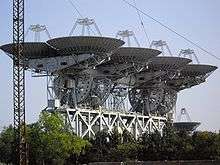Soviet Deep Space Network
The Soviet Deep Space Network is a network of large antennas and communication facilities that supports interplanetary spacecraft missions, and radio and radar astronomy observations for the exploration of the solar system and the universe. It was built to support the space missions of the Soviet Union. Similar networks are run by the USA, China, Europe, Japan, and India.
History

The first Soviet space network had 13 stations and was designed to track Earth orbiting satellites.[1] Interplanetary missions require larger antennas, more powerful transmitters, and more sensitive receivers, and this effort was started in 1959 to support the planned 1960 launch of the Venera series of missions to Venus and the Mars program of spacecraft to Mars. The selected design consisted of eight 16-meter dishes placed on two hulls of diesel submarines, welded together and laid down on the railway bridge trusses. These trusses were mounted on bearings from battleship gun turrets.[1] Three such antennas were built: the two North stations for receiving, and the south station a few kilometers away for transmitting.
In 1978, these antennas were augmented by the 70-meter antennas at Yevpatoria and Ussuriisk, with a third that was never completed at Suffa, Uzbekistan.
Facilities
.jpg)
There are three main antennas in this Deep Space Network:[2]
- A 70 meter antenna at Yevpatoria, in Crimea
- A 64-meter antenna[3] at Bear Lakes, near Moscow
- A 70 meter antenna at Ussuriisk, in Primorsky Krai, Russia
Missions
Some of the Soviet space program missions that have communicated by the Soviet DSN include:
- Venera 11 and Venera 12
- Venera 13, Venera 14, Venera 15, Venera 16
- Vega program
- Astron
- Phobos program
- Granat
- Interball
- Spektr-R
- Fobos-Grunt (in 2011)
References
- 1 2 Don P. Mitchel. Soviet Telemetry Systems. Deep-Space Communication Centers.
- ↑ Altunin, V. (1993). G.S. Shostak, ed. Prospects for Using Soviet DSN Antennas for SETI. Third Decennial US-USSR Conference on SETI. ASP Conference Series. 47. p. 37. Bibcode:1993ASPC...47...37A.
- ↑ I. Molotov (2002). Two-year program to upgrade Bear Lakes RT-64 for EVN membership (PDF). Proceedings of the 6th European VLBI Network Symposium.
